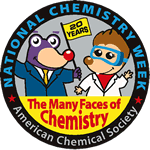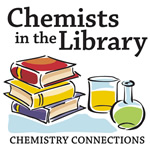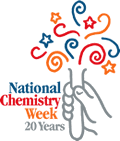Online Resources
This is a collection of online resources (websites, software, etc.). A separate collection of Print Resources is also available.
Key: E=Elementary (K–5), I=Intermediate (6–8), HS=High School (9–12), C=College, G=General Public
Careers in Chemistry and Science
- Adventures of Meg A. Mole — Future Chemist (E, I) (in English, en español)
- Learn about Meg’s adventures as she visits different chemists to learn about their jobs. Provided by: American Chemical Society.
- Careers in Chemistry (HS, C)
- This site gives a view of careers within the chemical sciences. It includes interviews with chemists plus info about educational requirements, employment outlook, salaries, and skills needed. Provided by: American Chemical Society.
- Chemists in Their Element (I, HS, C, G)
- A series of six careers posters showing how chemists are involved in the various stages of development of a range of exciting and everyday products — from sunglasses and trainers to cars and diapers. Provided by: Royal Society of Chemistry.
- Edutopia > School-to-Career Programs (E, I, HS)
- School-to-career programs engage parents, businesses, and community-based organizations in providing students with career-exploration opportunities. Provided by: The George Lucas Educational Foundation.
- Fun Works (I, HS)
- You may not know now exactly what you want to do as an adult, but this site will help you start. Discover who you are, what you like to do and what you do best. Provided by: Education Development Center.
- GirlsgoTech.org (E, I)
- Careers in math, science and technology are as varied as they are exciting. Read the activities on this site and then find out more about the careers associated with them. Provided by: Girl Scouts of the United States of America.
- Not All Chemists Wear White Coats (I, HS, C, G)
- A colorful series of posters showing how wide and varied your career can be if you study chemistry. Provided by: Royal Society of Chemistry.
- On Becoming a Scientist (I, HS, C, G)
- This online book has lesson plans, projects, and activities for teachers who want to help students explore scientific careers. Provided by: Access Excellence at the National Health Museum.
- Online Career Center (HS, C)
- A comprehensive center featuring workshops, career guidance, and accurate up-to-date information about the chemical job market for ACS Members and Affiliates. Provided by: American Chemical Society.
- Origins (I, HS, C, G)
- Science is a social activity, and its progress depends on researchers sharing information. Throughout the world, scientists by the thousands collaborate, compete, and constantly expand our understanding. Learn about scientific life through interviews, live broadcasts, and photos that capture the often-unseen moments of investigation. Provided by: The Exploratorium.
- Sloan Career Cornerstone Center (I, HS, C, G)
- This site offers a vast array of resources about a field as well as profiles of professionals working in them. A student section provides an overview of options for middle school, high school, undergraduate, and graduate students. Provided by: Sloan Career Cornerstone Center.
- That’s Chemistry! (HS, C, G)
- Attractive, eye-catching posters to promote careers using chemistry. Provided by: Royal Society of Chemistry.
- YouthRules! Preparing the 21st Century Workforce (HS, C, G)
- Early work experiences can be rewarding for young workers — providing great opportunities for teens to learn important work skills. This site provides quick access to information about labor laws that apply to young workers. Provided by: U.S. Department of Labor.
- What Chemists Do (HS, G)
- Chemists are the people who transform the everyday materials around us into amazing things. The knowledge gained through the study of chemistry opens many career pathways. Provided by: American Chemical Society.
- What Do You Like? Exploring Career Information from the Bureau of Labor Statistics (I)
- This site provides introductory career information for students in Grades 4–8. Most of the material on the site has been adapted from the Bureau’s Occupational Outlook Handbook — a career guidance publication for adults and upper-level high school students that describes the job duties, working conditions, training requirements, earnings levels, and employment prospects of hundreds of occupations. Provided by: U.S. Bureau of Labor Statistics.
- Women’s Adventures in Science (E, I)
- This multimedia site was designed to support kids, especially girls, in their scientific explorations so they learn the fundamental skills of scientific investigation and feel empowered to tackle such adventures. Provided by: National Academy of Sciences.
- Working Chemists with Disabilities: Expanding Opportunities in Science (HS, C, G)
- The goal of this online book is to open the door for those who are “able-minded” and have a passion for science. It provides useful “how-to” information for pre-college and college students with disabilities, for their family members and teachers, for working scientists with disabilities, and for employers. Of equal importance, it presents realistic role models of people with disabilities who are finding fulfillment in challenging science careers. Provided by: ACS Chemists With Disabilities Committee.
Biographies of Chemists and Other Scientists
- 100 Distinguished European Chemists — Celebration of 100 Distinguished European Chemists from the Chemical Revolution to the 21st Century (HS, C, G)
- This site contains a brief biography and details about achievements of distinguished European chemists from the end of the 18th century until the present day. Provided by: European Association of Chemical and Molecular Sciences.
- Academy of Achievement (I, HS, C, G)
- This site brings students face-to-face with the extraordinary leaders, thinkers and pioneers who have shaped our world. Provided by: Academy of Achievement.
- Biographical Memoirs (I, HS, C, G)
- Published since 1877, Biographical Memoirs provides a record of the life and work of our most distinguished (and deceased) leaders in the sciences, as witnessed and interpreted by their colleagues and peers. Books published 1995 to present are available online for free. Provided by: National Academies Press.
- Biographical Snapshots of Famous Women and Minority Chemists (HS, C, G)
- The primary objective of this Only@JCE Online column is to provide information about chemists who have made important contributions to chemistry. A short biographical “snapshot” of each chemist provides basic information about the person’s chemical work, gender, ethnicity, and cultural background. Provided by: Journal of Chemical Education.
- Biographies of Famous Chemists (HS, C, G)
- Part of Links for Chemists web site, contains links to profile of over 300 important chemists. Provided by: University of Liverpool.
- Chemical Achievers (HS, C)
- The Human Face of the Chemical Sciences — Teach your students about the individuals behind the major advances in the history of the chemical sciences. Rich with images and biographical details. Provided by: Chemical Heritage Foundation.
- Chemical Heritage Foundation > Chemistry Educational Resources (HS, C, G)
- Incorporate the history of the chemistry and the molecular sciences into the classroom with online resources from CHF. Site includes excellent online exhibits and in-depth teaching tools that highlight individuals who have made outstanding achievements in the history of the chemical and molecular sciences. Provided by: Chemical Heritage Foundation.
- CHF Chemistry WebQuests (HS)
- These activities in the popular WebQuest format allow students to investigate current and historic issues in chemical science. Provided by: Chemical Heritage Foundation.
- Eric Weisstein’s World of Scientific Biography (I, HS, C, G)
- This resource has been assembled over more than a decade by internet encyclopedist Eric W. Weisstein with assistance from the internet community. Currently contains 1,071 entries, 2,144 cross-references, and 222 figures. Provided by: Eric Weisstein and Wolfram.
- Explore Chemical History (E, I, HS, C, G)
- This area of our Web site offers timelines of achievement and biographical sketches that provide a broad overview of the history and heritage of the chemical and molecular sciences. Provided by: Chemical Heritage Foundation.
- Faces in the Molecular Sciences (I, HS)
- Two modules explore the work of pioneering scientists in the field of polymers (Faces in Polymers) and environmental chemistry (Faces in the Environment). Includes classroom activities. Provided by: Chemical Heritage Foundation.
- Faces of Science: African Americans in the Sciences (HS, C, G)
- This site profiles African Americans who have contributed to the advancement of science and engineering. Their accomplishments can serve as pathfinders to present and future engineers and scientists. Provided by: Mitchell Brown, UC-Irvine.
- Her Lab in Your Life: Women in Chemistry (I, HS, C)
- This companion Web site to the traveling exhibit showcases women who have helped create our modern world, and their historic contributions to science and technology. Provided by: Chemical Heritage Foundation.
- InterViews (HS, C, G)
- This site provides first-person accounts of the lives and work of National Academy of Sciences members. In these hour-long interviews, members talk about their research, why they became scientists, and other aspects of their research and careers. Provided by: National Academy of Sciences.
- Lemelson-MIT Program Celebrating Invention and Innovation (G)
- The Lemelson-MIT Program celebrates those inventors who turned their ideas into accomplishments. Provided by: Massachusetts Institute of Technology.
- Luminaries of the Chemical Sciences (ChemChronicles I) (HS, C, G)
- This site reviews the work of intellectual giants in chemistry.
Provided by: American Chemical Society.
See also ChemChronicles II: Enterprise of the Chemical Sciences that focuses on companies. - Nobel Prize in Chemistry (I, HS, C, G)
- The Nobel Prize in Chemistry has been awarded to 149 individuals since 1901. (Frederick Sanger was awarded the prize in both 1958 and 1980.) Watch video interviews with many of the recipients or read articles to learn more. Provided by: The Nobel Foundation.
- Pharmaceutical Achievers (I, HS)
- The Human Face of Pharmaceutical Research — Three modules explore the history and science of over-the-counter pain relievers (Aspirin Adventures); cancer detection, treatment, and prevention (Magic Bullets); and antibiotics and the treatment and prevention of infectious disease (Antibiotics in Action). Includes classroom activities. Provided by: Chemical Heritage Foundation.
- Polymers and People (HS, C)
- An Informal History — Based on the traveling exhibit of the same name, this site gives the stories and faces behind some of the most important discoveries in the science of plastics, rubber, and other polymers. Provided by: Chemical Heritage Foundation.
- Real Science! (I, HS)
- Based on the Emmy Award-winning weekly series that takes America’s young viewers out for a day on-the-job with science professionals, this site provides resources for educators of students in grades 5 to 12 that include career information, vocabulary, and teaching tips. It has interviews with over 170 different scientists. Provided by: Allison Woodruff, Producer, Real Science.
- Robert Boyle Project (HS, C, G)
- Robert Boyle was one of the most significant of British scientists. More than anyone else, he invented the modern experimental method. His profuse published findings on pneumatics, chemistry and many other scientific topics were widely influential in providing empirical support for a mechanical view of nature. He also wrote books on the philosophical aspects of science, and on religion. Provided by: Birkbeck College, University of London.
- Science Alive! (I)
- The Life and Science of Percy Julian — Students learn about perseverance in science and society through the life story of Percy Julian, an African American chemist who synthesized cortisone and a treatment for glaucoma. Includes classroom activities. Provided by: Chemical Heritage Foundation.
- Spinning the Elements (HS, C)
- Wallace Carothers and the Nylon Legacy — This site tells the story of nylon and its inventor, Wallace Carothers. Students also learn about the scientific and engineering aspects of nylon. Includes an extensive photo gallery. Provided by: Chemical Heritage Foundation.
- Vega Science Trust (HS, C, G)
- Vega is a not for profit trust which broadcasts science programs for free over the internet. Their programs feature experts in science and engineering and many have been broadcast on mainstream television. This site contains a growing archive of some of the world’s most famous scientists who discuss their lives and discoveries as well as their concerns. Provided by: Vega Science Trust.
- Women in Science and Engineering (I, HS, C, G)
- This online exhibit features photographs and biographies of famous women scientists. Women have contributed richly to the achievements of science and engineering in the U.S but unfortunately many of these accomplishments have been forgotten, ignored, and even hidden as a result of cultural and social norms. Recent years have seen great strides in recognizing the contributions of women in all disciplines and fields of study. Compiled by Fred Stoss and Carole Ann Fabian. Provided by: University of Buffalo Libraries.


